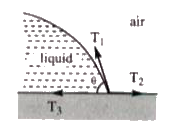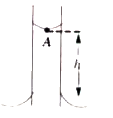The lower end of a capillary tube of diameter 2.00mm is dipped 8.00cm below the surface of water in a beaker. What is the pressure required in the tube in order to blow a hemispherical bubble at its end in water? The surface tension of water at temperature of the experiments is 7.30×102Nm−1.1 atmospheric pressure =1.01×105Pa density of water =1000kg/m3,g=9.80ms−2. Also calculate the excess pressure.Solution in Telugu
146
1.078×105
1.0193×105
1.02×104
The correct Answer is:C
Step by step video, text & image solution for The lower end of a capillary tube of diameter 2.00mm is dipped 8.00cm below the surface of water in a beaker. What is the pressure required in the tube in order to blow a hemispherical bubble at its end in water? The surface tension of water at temperature of the experiments is 7.30 times 10^2 Nm^-1.1 atmospheric pressure =1.01 times 10^5 Pa density of water =1000 kg//m^3,g=9.80 ms^-2. Also calculate the excess pressure. by Physics experts to help you in doubts & scoring excellent marks in Class 11 exams.
Topper's Solved these Questions
- BOOK - AAKASH SERIESCHAPTER - SURFACE TENSIONEXERCISE - ADDITIONAL PRACTICE EXERCISE ( LEVEL-II LECTURE SHEET (ADVANCED)STRAIGHT OBJECTIVE TYPE QUESTIONS )4videos
SURFACE TENSION
- BOOK - AAKASH SERIESCHAPTER - SURFACE TENSIONEXERCISE - ADDITIONAL PRACTICE EXERCISE ( LEVEL-II LECTURE SHEET (ADVANCED) LINKED COMPREHENSION TYPE QUESTIONS)2videos
SURFACE TENSION
- BOOK - AAKASH SERIESCHAPTER - SURFACE TENSIONEXERCISE - PRACTICE SHEET ( EXERCISE-III Miscellaneous LEVEL - II LINKED COMPREHENSION TYPE QUESTIONS)6videos
SURFACE TENSION
- BOOK - AAKASH SERIESCHAPTER - SIMPLE HARMONIC MOTION EXERCISE - ADDITIONAL PRACTICE EXERCISE (LEVEL - II)(PRACTICE SHEET (ADVANCED)) (INTEGER TYPE QUESTIONS)3videos
SIMPLE HARMONIC MOTION
- BOOK - AAKASH SERIESCHAPTER - SYSTEM OF PARTICLES AND ROTATIONAL MOTIONEXERCISE - PRACTICE EXERCISE99videos
SYSTEM OF PARTICLES AND ROTATIONAL MOTION
Similar Questions
When a drop splits up into a number of drops
05:10View SolutionThe property of surface tension tends to persists even if a liquid is solidified. Hence, solids can also be assumed to possess surface tension. Consider a liquid in contact with a solid with air above. Let T1,T2 and T3 be the surface tension at the liquid-air interface, solid-air interface and the solid-liquid interface.

The liquid drop will spreads on the solid surface if05:29View SolutionThe figure shows a capillary tube of radius r dipped into water. The atmospheric pressure is p0 and the capillary rise of water is h. the surface tension for water-glass is s

The pressure inside water at the point A (lowest point of the ineniscus) is02:23View SolutionConsider the motion of a ball in a tunnel through the earth (radius of the earth is R and mass of the earth is M), the tunnel is along a chord and the ball is released from the surface. The time period of the ball is √x (approx), find x.
05:40View SolutionThe centre of mass of two particles with masses 2kg and 6 kg located at (1,1,1), (2,2,1) respectively has the coordinates
View SolutionA narrow capillary tube is dipped 10cm below water surface and a liquid bubble of radius 2mm formed at the lower end by blowing air through the tube.
a. Calculate the excess pressure due to surface tension.
b. What is the pressure required in the tube in order to blow a hemispherical bubble at its end in water?
The surface tension of water at temperature of the experiment is 7.30×10−2N/m. 1 atmospheric pressure =105Pa, density of water =1000kg/m303:30View SolutionThe lower end of a capillary tube of diameter 2.0 mm is dipped 8.00cm below the surface of water in a beaker. What is the pressure required in the tube in order to blow a hemispherical bubble at its end in water? The surface tension of water at temperature of the experiments is 7.30×10−2Nm−1. 1 atmospheric pressure =1.01×105Pa, density of water =1000kg/m3,g=9.80ms−2. also calculate the excess pressure.
05:54View SolutionA capillary tube is dipped in water with the lower and 10 cm below the surface. Water rises in the tube to a height of 5 cm. The pressure required to blow a bubble at the lower end of the tube will be (atmospheric pressure = 10^5 Nm^(-2) and g = 10 m//s^2 )
04:25View Solution2.00 mm व्यास की किसी केशनली का निचला सिरा बीकर में भरे जल के पृष्ट से 8.00 cm निचे तक डुबोया जाता है। नली के जल में दुबे सिरे पर अर्घगोलीअ बुलबुला फूलने के लिए नाली के भीतर आवश्यक दाब ज्ञात कीजिये। प्रयोग के ताप पर जल का पृष्ट तनाव 7.30×10−2Nm−1 है। जल का घनत्व =1000k/m3, वायुमंडलीय दाब =1.01×105 Pa तथा g=9.80ms2|दाब आधिक्य भी परिकलित कीजिये।
View SolutionThe lower end of a capillary tube of diameter 2.00 mm is dipped 8.00 cm below the surface of water in a beaker. What is the pressure required in the tube in order to blow a hemispherical bubble at its end in water? The surface tension of water at the temperature of the experiments is 7.30 xx 10^(-2) "N/m" . 1 atmospheric pressure =1.01 xx 10^(5) Pa density of water =7000" kg/m"^(3), g="9.80 ms"^(-2) . Also calculate the excess pressure.
05:17View SolutionThe lower end of a capillary tube of diameter 2.00mm is dipped 8.00cm below the surface of water in a beaker. What is the pressure required in the tube in order to blow a hemispherical bubble at its end in water? The surface tension of water at temperature of the experiments is 7.30×10−2Nm−1.1 atmospheric pressure =1.01×105Pa density of water =1000kg/m3,g=9.80ms−2. Also calculate the excess pressure.
04:11View SolutionThe lower end of a capillary tube of diameter 2.00mm is dipped 8.00cm below the surface of water in a beaker. What is the pressure required in the tube in order to blow a hemispherical bubble at its end in water? The surface tension of water at temperature of the experiments is 7.30 times 10^2 Nm^-1 .1 atmospheric pressure =1.01 times 10^5 Pa density of water =1000 kg//m^3,g=9.80 ms^-2 . Also calculate the excess pressure.
04:38View SolutionThe lower end of a capillary tube of diameter 2.00mm is dipped 8.00cm below the surface of water in a beaker. What is the pressure required in the tube in order to blow a hemispherical bubble at its end in water? The surface tension of water at temperature of the experiments is 7.30×102Nm−1.1 atmospheric pressure =1.01×105Pa density of water =1000kg/m3,g=9.80ms−2. Also calculate the excess pressure.
View SolutionThe lower end of a capillary tube of diameter 2.00mm is dipped 8.00cm below the surface of water in a beaker. What is the pressure required in the tube in order to blow a hemispherical bubble at its end in water? The surface tension of water at temperature of the experiments is 7.30 times 10^2 Nm^-1 .1 atmospheric pressure =1.01 times 10^5 Pa density of water =1000 kg//m^3,g=9.80 ms^-2 . Also calculate the excess pressure.
04:25View SolutionThe lower end of a capillary tube of diameter 2.0 mm is dipped 8.00cm below the surface of water in a beaker. What is the pressure required in the tube in order to blow a hemispherical bubble at its end in water? The surface tension of water at temperature of the experiments is 7.30×10−2Nm−1. 1 atmospheric pressure =1.01×105Pa, density of water =1000kg/m3,g=9.80ms−2. also calculate the excess pressure.
View SolutionThe lower end of a capillary tube of diameter 2.00 mm is dipped 8.00 cm below the surface of water in a beaker . What is the pressure required in the tube in order to blow a hemispherical bubble at the end in water ? The surface tension of water at temperature of the experiments is 7.30×10−2Nm9−1.
1 atmospheric pressure =1.01×105Pa.
Density of water =1000kg/m3,g=9.80ms−2.
Also calulate the excess pressure .07:04View Solution
